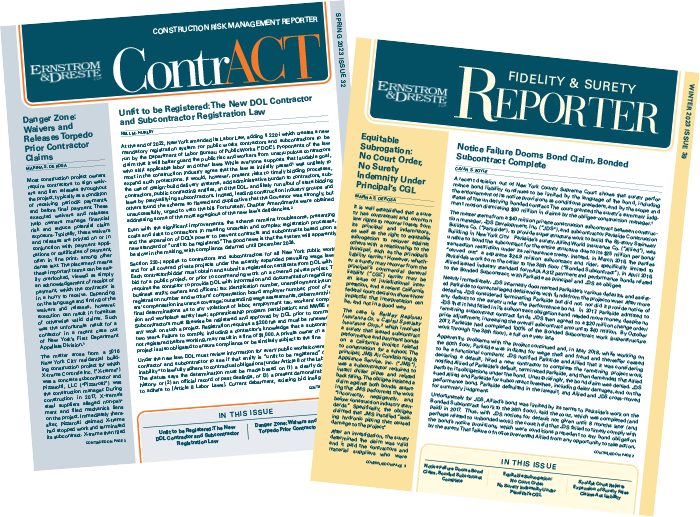Article by: Nell M. Hurley
When a principal is terminated, the surety must suss out the strength of its principal’s claims and defenses in short order, including whether the obligee may have breached the contract, to decide how to respond to the likely performance bond claim. If the facts support it, the surety may determine that the best thing to do is deny the claim, betting that it can show a prior material breach by the obligee discharged its bond obligations.1
Sometimes this works out well for the surety, as in a recent case from New York where the U.S. Court of Appeals for the Second Circuit upheld a district court’s trial determination that the obligee-general contractor’s failure to clear impediments to delivery and installation of windows by the principal-subcontractor was a breach of the subcontract that discharged the surety’s bond obligations.2
The matter involved construction of luxury condominiums in Manhattan in which the sub was to supply and install custom windows per a $1.85 million subcontract, with an AIA A312 subcontractor performance bond running to the general contractor-obligee. The obligee later terminated the sub for failure to timely perform and made a claim on the bond. The surety denied the claim, saying the obligee had breached first, constituting an “owner default” under the bond such that the surety’s obligation did not arise. The obligee then sued the surety for its costs to complete the subcontract.
At issue was a letter between the contracting parties with a revised schedule that the obligee argued the sub had failed to meet. The letter also set forth a condition that required the obligee to ensure that the site was free of debris and protrusions prior to window installation. After a four-day bench trial, the district court found that the letter’s terms became a part of the subcontract and that numerous obstructions prevented the sub from delivering windows to the site, resulting in a prior breach of the subcontract by the obligee.
In a post-trial motion, the obligee argued that the letter never became a part of the subcontract because the “subcontract required that modifications be made with a signed writing” so that its terms were not enforceable against the obligee.3 The district court, and then the Second Circuit, found that the argument was waived since it was not raised until after the court’s determination, including no mention of it in the obligee’s proposed findings of fact and conclusions of law after the trial. The dismissal of the action against the surety by the district court was affirmed.
A similar recent federal case tells a different story.4 There, the subcontractor bond applied to a $2.6 million contract in which the principal-subcontractor was to fabricate, supply and install metal panels, metal screens, and architectural louvres on a high-rise building in Virginia as part of a larger project by the general contractor-obligee. Following delays, the obligee terminated the subcontract and called on the bond. The surety denied the bond claim based upon evidence that the obligee had breached first, electing not to remedy the default or complete the subcontract.
The sub later sued the obligee, alleging the obligee issued late/defective design documents, was negligent in its management of the project, interfered in the sub’s work, failed to pay, and wrongfully terminated the subcontract. The obligee counterclaimed against the sub alleging the sub breached the subcontract by failing to: submit shop drawings, complete fabrication of metal panels, timely mobilize work, install and complete installation of the panels. The obligee also sued the surety on the bond for its costs to complete the subcontract.
The Maryland federal district court ultimately held a five-day trial. In a detailed 32-page decision, the court found the sub’s claims against the obligee for late/defective design documents and delays to be largely unsubstantiated. Instead, said the court, the sub had materially breached the subcontract by failing to timely mobilize, failing to timely complete fabrication of the panels, and failing to timely progress and complete panel installation. The court further found that the surety was thus liable to the obligee for “all expenses, including attorneys’ fees, of completion” up to the penal sum of the bond ($2.6 million).5
What explains the differing results? Unfortunately for sureties, every default situation is factually, contractually, and financially unique, requiring a multi-factor assessment of the surety’s response. There was strong evidence supporting a prior breach by the obligee in both cases and each reached trial, meaning resolution required fact-finding, including the credibility of witnesses and experts. But trial itself is inherently risky, making it difficult to reliably forecast the result. As such, these cases show that where there is a denial of liability, even the most thorough investigation and analysis may culminate in a decision by the trier of fact, making the outcome unpredictable and requiring the surety to expect the unexpected.
- Industry standard performance bonds typically include a pre-condition that the obligee be free from its own default to recover under the bond.
- E & T Skyline Constr., LLC v. Talisman. Cas. Ins. Co., LLC, 2025 WL 100621 (2d Cir. Jan. 15, 2025).
- Interestingly, the obligee relied upon the letter’s revised schedule in its notices of default.
- Bunting Graphics, Inc. v. Whiting-Turner Contr. Co., 2025 WL 299211 (D. Md. Jan. 23, 2025).
- While the specific bond form used was not clear, its terms limited the surety’s obligation to the penal sum of the bond where the surety does not remedy the default or complete the subcontract as permitted by the bond.





